REFERENCIAS CAPÍTULO 1
Anuncio
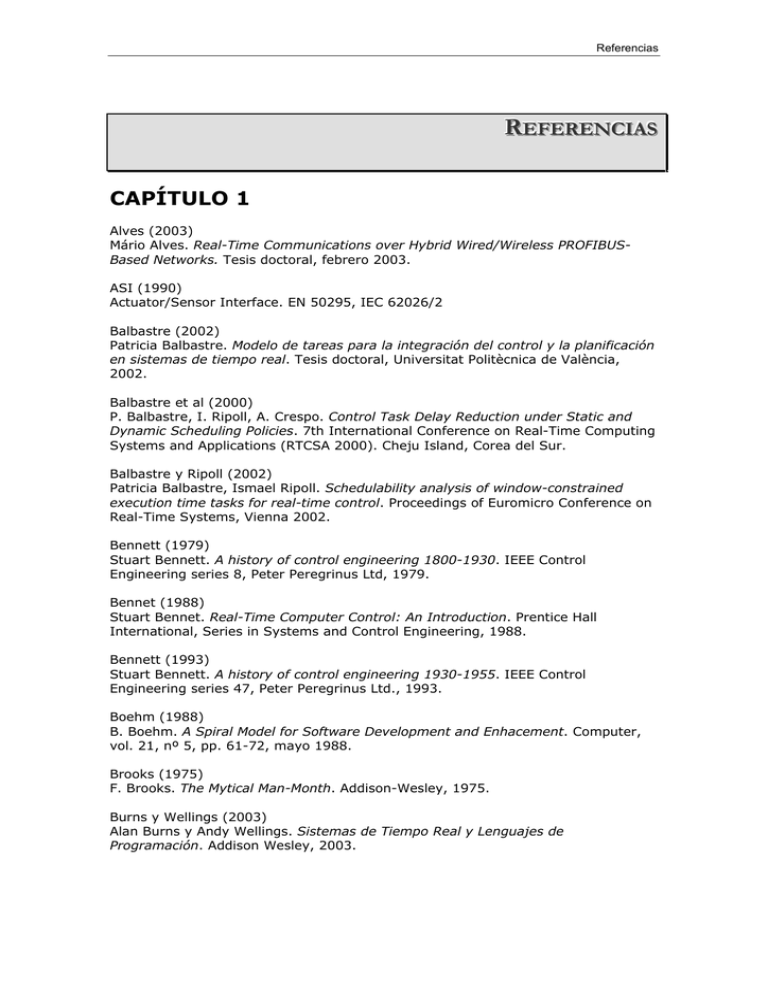
Referencias R REEFFEERREEN NC CIIA ASS CAPÍTULO 1 Alves (2003) Mário Alves. Real-Time Communications over Hybrid Wired/Wireless PROFIBUSBased Networks. Tesis doctoral, febrero 2003. ASI (1990) Actuator/Sensor Interface. EN 50295, IEC 62026/2 Balbastre (2002) Patricia Balbastre. Modelo de tareas para la integración del control y la planificación en sistemas de tiempo real. Tesis doctoral, Universitat Politècnica de València, 2002. Balbastre et al (2000) P. Balbastre, I. Ripoll, A. Crespo. Control Task Delay Reduction under Static and Dynamic Scheduling Policies. 7th International Conference on Real-Time Computing Systems and Applications (RTCSA 2000). Cheju Island, Corea del Sur. Balbastre y Ripoll (2002) Patricia Balbastre, Ismael Ripoll. Schedulability analysis of window-constrained execution time tasks for real-time control. Proceedings of Euromicro Conference on Real-Time Systems, Vienna 2002. Bennett (1979) Stuart Bennett. A history of control engineering 1800-1930. IEEE Control Engineering series 8, Peter Peregrinus Ltd, 1979. Bennet (1988) Stuart Bennet. Real-Time Computer Control: An Introduction. Prentice Hall International, Series in Systems and Control Engineering, 1988. Bennett (1993) Stuart Bennett. A history of control engineering 1930-1955. IEEE Control Engineering series 47, Peter Peregrinus Ltd., 1993. Boehm (1988) B. Boehm. A Spiral Model for Software Development and Enhacement. Computer, vol. 21, nº 5, pp. 61-72, mayo 1988. Brooks (1975) F. Brooks. The Mytical Man-Month. Addison-Wesley, 1975. Burns y Wellings (2003) Alan Burns y Andy Wellings. Sistemas de Tiempo Real y Lenguajes de Programación. Addison Wesley, 2003. Referencias CAN (1991) Controller Area Network. Bosch CAN specification, V 2.0 PartA. R. Bosch Gmbh, 1991. Crespo et al (1994) Crespo, V. Botti, F. Barber, D. Gallardo, E. Onaindia. A Temporal Blackboard for real-time process control. Journal of Engineering Applications of Artificial Intelligence. Vol 7. Nº 3, junio 1994. Pp 255-266. DOCE (2002) Diario Oficial de las Comunidades Europeas. 29-10-2002. L294/1-43. Programa específico de investigación, desarrollo tecnológico y demostración denominado «Integración y fortalecimiento del Espacio Europeo de la Investigación» (20022006). (2002/834/CE) Dyer (1992) M. Dyer. The Cleanroom Approach to Quality Software Development. Wiley, 1992. FF (1997) Foundation Fieldbus. EN 50170/A, IEC 61158 Type 1. Heck et al (2003) Bonnie S. Heck, Linda M. Wills, George J. Vachtsevanos. Software Technology for Implementing Reusable, Distributed Control Systems. IEEE Control Systems Magazine, pp. 21-35, febrero 2003. Hughes (1990) John Hughes. Why Functional Programming Matters. In D. Turner, editor, Research Topics in Functional Programming. Addison Wesley, 1990. IEEE (1993) IEEE. Standards Collection: Software Engineering. IEEE Standard 610.12-1990, IEEE 1993 ISO (1978) International Organization for Standardization. Open Systems Interconnection-Basic Reference Model. ISO 7498, 1978. Kerr y Hunter (1994) J. Kerr y R. Hunter. Inside RAD. McGraw Hill, 1994. Kuo (1996) Benjamin C. Kuo. Sistemas de Control Automático. Séptima Edición. Prentice Hall Hispanoamericana, 1996. Laplante (1997) Phillip A. Laplante. Real-Time Systems Design and Analysis. IEEE Press, 1997. Lian (2001) Feng-Li Lian. Analysis, Design, Modeling, and Control of Networked Control Systems. Tesis doctoral, The University of Michigan, mayo 2001. Lian et al (2001) Feng-Li Lian, James R. Moyne, and Dawn M. Tilbury, Performance evaluation of control networks: Ethernet, ControlNet, and DeviceNet. IEEE Control Systems Magazine, Vol. 21, No. 1, Page(s): 66-83, febrero 2001. Referencias Martí (2002) Pau Martí. Analysis and Design of Real-Time Control Systems with Varying Control Timing Constraints. Tesis doctoral, Universitat Politècnica de Catalunya, 2002. Mazzocchi (2003) Stefano Mazzocchi. Introduccing Cocoon. http://cocoon.apache.org/2.1/introduction.html McDermid y Rook (1993) J. McDermid y P. Rook. Software Development Process Model. Software Engineer’s Reference Book, CRC Press, pp. 15/26-15/28, 1993. Murray et al (2003) Richard M. Murray, Karl J. Åström, Stephen P. Boyd, Roger W. Brockett, Gunter Stein. Future Directions in Control in an Information-Rich World. IEEE Control Systems Magazine, pp. 20-33, abril 2003. Ogata (1998) Katsuhiko Ogata. Ingeniería de Control Moderna. Tercera Edición. Prentice Hall Hispanoamericana, 1998. Otanez (2002) Paul Otanez. Performance Optimization of Networked Control Systems. Tesis doctoral, The University of Michigan, abril 2002. Palencia (1999) José Carlos Palencia Gutiérrez. Análisis de planificabilidad de sistemas distribuidos de tiempo real basados en prioridades fijas. Tesis doctoral, Universidad de Cantabria, 1999. Palencia y González Harbour (2003) J.C. Palencia and M. González Harbour. Offset-Based Response Time Analysis of Distributed Systems Scheduled under EDF. Proceedings of Euromicro Conference on Real-Time Systems (ECRTS03), Porto, Portugal, July 2003. Pimentel (1990) Juan R. Pimentel. Communication networks for manufacturing. Prentice-Hall Internacional Editions, 1990. Pinto (1999) Jim Pinto. The Great Fieldbus debate - is Over!. Industrial Controls Intelligence, noviembre 1999. Presman (2002) Roger S. Pressman. Ingeniería del Software. Un enfoque práctico. (5ª edición) Editorial McGraw Hill, 2002. PROFIBUS (1992) PROcess Field BUS. Profibus Standard. DIN19245 part I and II, EN 50 170, 1992. Rajkumar (1991) Ragunathan Rajkumar. Synchronization in real-time systems. A priority inheritance approach. Kluwer academic publishers, 1991. Royce (1970) W. W. Royce. Managing the development of large software systems: concepts and techniques. Proceedings WESCON, agosto 1970. Referencias Sáez et al (2000) Sergio Sáez, Joan Vila and Alfons Crespo. On Accepting Aperiodic Transactions in Distributed Systems. Proceedings of 7th International Conference on Real-Time Computing Systems and Applications. Cheju-do, South Korea, diciembre 2000. Sink (2002) Sink P. Industrial Ethernet: A Pocket Guide. ISA Press, 2002 Sommerville (1992) Ian Sommerville. Software Engineering. Fourth edition. Addison-Wesley, 1992. Spyevy (1992) J. M. Spyevy. The Z Notation: A Reference Manual. Prentice-Hall, 1992. Tindell et all (1995) K. Tindell, A. Burns and A.J. Wellings. Analysis of Hard Real-Time Communications. Real-Time Systems, Vol. 9(2), pp. 147-171, Kluwer Academic Publishers, September 1995. Tindell y Burns (1994) Tindell, K. and Burns, A. Guaranteeing Message Latencies on Controller Area Network (CAN). Proceedings 1st International CAN Conference, pp. 2-11, Mainz (Germany), September 1994. Tindell y Clark (1994) Tindell, K. and Clark, J. Holistic schedulability analysis for distributed hard real-time systems. Microprocessing & Microprogramming, Vol. 50 Nºs 2-3, pp. 117-134, Abril 1994. Törngren (1998) Martin Törngren. Fundamentals of implementing real-time control applications in distributed computer systems. Real-Time systems, Kluwer Academic Publishers, vol 14, 219-250, nº 3, mayo 1998. Tovar (1999) Eduardo Tovar. Supporting Real-Time Communications with Standard Factory-Floor Networks. Tesis doctoral, The Polytechnic Institute of Porto, mayo 1999. Yook et al (2000) J. K. Yook, D. M. Tilbury, N. R. Soparkar. A Design Methodology for Distributed Control Systems to Optimize Performance in the Presence of Time Delays. Proceedings of the American Control Conference, Chicago, June 2000. Referencias CAPÍTULO 2 Agha (1986) Agha G. Actors: A Model of Concurrent Computation in Distributed Systems. MIT Press, Cambridge,MA, 1986. Aho et al (1986) A.V. Aho, R. Sethy, J. Ullman. Compilers: Principles, Techniques and Tools. Addison-Wesley, Reading, MA, segunda edición, 1986. ANSI/IEEE (2000) ANSI/IEEE 1471-2000. Recommended Practice for Architectural Description of Software Intensive System, octubre 2000. Award et al (1996) Awad, M., Kuusela J, Jurgen Ziegler. Object Oriented Technology for Real-Time Systems. Prentice Hall. 1996. Bass et al (1994) Bass, J. M., A. R. Browne, M. S. Hajji, D. G. Marriott, P. R. Croll and P. J. Fleming. Automating the Development of Distributed Control Software. IEEE Parallel and Distributed Technology, Vol. 2, No. 4, Winter 1994, pp. 9-19. Boehm (1989) Boehm, B. W. Verifying and Validating Software Requirements and Design Specifications. Software Risk Management ,IEEE Computer Society Press, pp.205218, 1989. Browne et al (1996) Browne, A. R., J. M. Bass, M. S. Hajji, P. R. Croll and P. J. Fleming. A Prototype Development Framework for Parallel Real-Time Control Software. Transputer Communications, special issue on CASE for parallel systems, Vol 3, No. 1, January 1996, pp. 69-77. Burns y Wellings (1995) Burns, A., Wellings A. HRT-HOOD: A Structured Design Method for Hard Real-Time Ada Systems. Real-time Safety Critical Systems. Vol. 3. Elsevier. 1995. Egyed (2000) Egyed A.F. Heterogeneous View Integration and its Automation. Tesis doctoral. University of Southern California. Agosto 2000. Grose et al (2002) Timothy J. Grose, Gary C. Doney, Stephen A. Brodsky. Mastering XMI. Java programming with XMI, XML and UML. OMG Press, Wiley, 2002. Hajji et al (1997) Hajji, M.S., J. M. Bass, A. R. Browne and P. J. Fleming. Design Tools for Hybrid Control Systems. Int. Workshop on Hybrid and Real-Time Systems, HART ‘97, Oded Maler (Ed.), Grenoble, France, LNCS 1201, Springer-Verlag, March 1997, pp. 8792. Harel et al (1990) Harel, D., H. Lachover, A. Naamad, A. Pnueli, M. Politi, R. Sherman, A. ShtullTrauring and M. Trakhtenbrot, STATEMATE: A Working Environment for the Development of Complex Reactive Systems, IEEE Transactions on Software Engineering, Vol. 16, pp. 403-414, 1990. Referencias Hopcroft et al (2000) J.E. Hopcroft, R. Motwani, J. Ullman. Introduction to autómata theory, languages and computation, 2nd edition. Addison Wesley,2000. Hylands et al (2003) Hylands C., Lee E., Liu J., Liu X., Neuendorffer S., Xiong Y., Zhao Y., Zheng H. Overview of the PTOLEMY project. Technical Memorandum UCB/ERL M03/25. http://ptolemy.eecs.berkeley.edu/. Julio 2003. Jacobson et al (2000) Ivar Jacobson, Grady Booch, James Rumbaugh. El Proceso Unificado de Desarrollo de Software. Addison Wesley, 2000. Kruchten (1995) Kruchten, P. The 4+1 View Model of Architecture. IEEE Software 12(6): 42-50. 1995. Lee (2000) Edward A. Lee. What's Ahead for Embedded Software?. IEEE Computer Magazine, Septiembre 2000, pp. 18-26. Locke (1999) Locke C.D. An Architectural Perspective of Real-Time Ada Applications. Reliable Software Technologies- Ada Europe 99. Lecture Notes in Computer Science 1622. Springer Verlag, 1999. Mazzini et al (2003) Mazzini S., D'Alessandro M., Di Natale M., Domenici A., Lipari G., Vardanega T.. HRT-UML: Taking HRT-HOOD onto UML. 8th International Conference on Reliable Software Technologies, Ada-Europe 2003, Toulouse, Francia, junio 2003. McDermid (1993) J. McDermid. Formal Methods: Use and relevance for the development of safety critical systems. Safety Aspects of Computer Control, Ed P A Bennett, Butter-worth Heinemann, 1993. Medvidovic y Taylor (2000) Medvidovic N. y Taylor R.N. A Classification and Comparison Framework for Software Architecture Description Languages. IEEE Transactions on Software Engineering, vol. 26, no. 1. Enero 2000. Millar y Mukerji (2001) Millar J y Mukerji J. Model Driven Architecture (MDA). OMG, ormsc/2001-07-01, Architecture Board ORMSC1, Julio 2001. www.omg.org/mda/specs.htm Moore y Cooling (2000) A. Moore, N. Cooling. Developing real-time Systems using Object Technology. Foundation and Overview version 1.3. www.artisansw.com, 2000. OMG (2003) OMG. Final draft of the Schedulability Profile. ptc/03-03-02, 2 de marzo 2003. Paulk et al (1995) Paulk, M. C., Weber, C. V., Curtis, B., and Chrissis, M. B.. The Capability Maturity Model for Software: Guidelines for Improving the Software Process. AddisonWesley, 1995 Referencias Pruitt et al (1998) Steve Pruitt, Doug Stuart, T.W. Cook. The merit of XML as an Architecture Description Language Meta-Language. Microelectronics and Computer Technology Corp, octubre 1998. Rodríguez Polo (2003) Óscar Rodríguez Polo. EdROOM, una herramienta abierta para el desarrollo de sistemas software de tiempo real basados en componentes. Tesis doctoral. Universidad Complutense de Madrid. Marzo 2003. Selic et al (1994) Bran Selic, Garth Gullekson, Paul T. Ward. Real-Time Object-Oriented Modeling. John Wiley & Sons 1994. Shaw (1995) Shaw,M. Comparing Architectural Design Styles. IEEE Software. Noviembre 1995. Shaw y Clements (1997) Mary Shaw, Paul C. Clements. A Field Guide to Boxology: Preliminary Classification of Architectural Styles for Software Systems. COMPSAC '97, 21st International Computer Software and Applications Conference, agosto 1997, Washington, DC. Sprunt et al (1989) Sprunt, H.M.B., Sha, L., Lehoczky, J.P. Aperiodic Task Scheduling on Hard RealTime Systems. Real-Time Systems Journal, Kluwer Publishers, 1989. Zamorano et al (1997) Zamorano, J. A. Alonso, J.A. de la Puente. Building Safety Critical Real-Time Systems with Reusable Cyclic Executives. Control Engineering Practice, vol. 5, pp.999-1005. 1997 Referencias CAPÍTULO 3 Bauer et al (1989) F.L. Bauer, B. Moller, H. Partsch, P. Pepper. Formal Program Construction by Transformations-Computer-Aided, Intuition-Guided Programming. Software Engineering, Vol. 15, No. 2, febrero 1989. Bennis y Biederman (1998) Bennis, W. and Biederman, P. W. None of Us Is As Smart As All of Us. IEEE Computer, Vol. 31, No. 3, 1998, pp. 116-117 Berners-Lee (1999) Tim Berners-Lee. Weaving the Web. The Original Design and Ultimate Destiny of the World Wide Web. HarperSanFrancisco, septiembre 1999. Boehm (1981) Barry W. Boehm. Software Engineering Economics. Prentice- Hall, Inc., 1981. Carlson (2001) David Carldon. Modelling XML Applications with UML, Addison Wesley, 2001. Cleaveland (2001) J. Craig Cleaveland. Program Generators with XML and Java. Prentice Hall PTR, 2001. Czarnecki y Ulrich (2000) Krzysztof Czarnecki and Ulrich W. Eisenecker. Generative Programming. Methods, Tools, and Applications. Addison-Wesley, junio 2000. Dijkstra (1976) Edsger W. Dijkstra. A Discipline of Programming, Prentice Hall, 1976. Doorfman y Thayer (1996) Merlin Dorfman, Richard H. Thayer. Software Engineering. IEEE Computer SocietyWiley. Septiembre 1996. Fielding (2000) Fielding, Roy Thomas. Architectural Styles and the Design of Network-based Software Architectures. Doctoral dissertation, University of California Irvine, 2000. http://www.ics.uci.edu/~fielding/pubs/dissertation/top.htm. Garbajosa (2002) Garbajosa, J. A Low Cost Software Engineering Environment for On-Board Real Time Software. 1st Workshop on Advanced Real-Time Technologies, Aranjuez (Spain), octubre 2002. Guttag y Horning (1993) Guttag, J. V. y J.J. Horning. Larch: Languages and tools for formal specifications. Springer-Verlag, 1993. Hinchley y Jarvis (1995) Hinchley, M.G. y S.A. Jarvis. Concurrent Systems: Formal development in CSP. McGraw-Hill, 1995. Jacobs (2003) Jacobs I. Architecture of the World Wide Web. W3C Working Draft 27 June 2003. http://www.w3.org/TR/2003/WD-webarch-20030627/ Referencias Jones (1991) Jones, C.B. Systematic development using VDM. Prentice Hall, 1991. Lamport (1989) Leslie Lamport. A Simple Approach to Specifying Concurrent Systems. Communications of the ACM, volumen 32, nº 1, enero 1989. Lee (2000) Edward A. Lee. Concurrent Models of Computation in System-Level Design. Forum on Design Languages (FDL), Tubingen, Alemania. Septiembre 2000. Linger (1994) Linger, R. Cleanroom Process Model. IEEE Software, vol. 11, nº 2, pp. 50-58, marzo 1994. McLean (1993) McLean. The Seventh Knowledge-Based Software Engineering Conference: Proceedings:Virginia September 20-23, 1992. IEEE Computer Society. Enero 1993. Oberndorf (1998) Oberndorf P. COTS and Open Systems. Carnegie Mellon SW Engineering Institute (SEI) Monographs on the Use of Commercial Software in Government Systems. Febrero 1998. Ossher y Tarr (2000) H. Ossher and P. Tarr. Multi-Dimensional Separation of Concerns and The Hyperspace Approach. Proceedings of the Symposium on SW Architectures and Component Technology: The State of the Art in SW Development. Kluwer, 2000. Rus et al (2001) I. Rus, M. Lindvall and S.S. Sinha. Knowledge Management in Software Engineering-A DACS State-of-the-Art Report. Produced by Fraunhofer Center for Experimental Software Engineering Maryland and The University of Maryland Simonyi (1995) C. Simonyi. The death of computer languages, the birth of Intentional Programming. Tech. Rep. MSR-TR-95-52, Microsoft Research, 1995. Spievy (1992) Spievy, J.M. The Z notation: a reference manual. Prentice.Hall, 1992 W3C (1999) World Wide Web Consortium. XSLT: XSL Transformations. Version 1.0. W3C Recommendation, 16 noviembre 1999. W3C (1999b) World Wide Web Consortium. XPath: XML Path Language. Version 1.0. W3C Recommendation, 16 noviembre 1999. W3C (2003) World Wide Web Consortium. Web Services Architecture. http://www.w3.org/TR/2003/WD-ws-arch-20030808/ W3C Working Draft 8 August 2003. Referencias CAPÍTULO 4 Bentley (1986) Jon Bentley. Little languages. Communications of the ACM, 29(8):711-721, agosto 1986. Bentley (2000) Jon Bentley. Programming Pearls, Second Edition. Addison-Wesley, Inc., 2000. Bentley y Bentley (1988) Bentley J.L., Bentley J. More Programming Pearls: Confessions of a Coder, AddisonWesley, Reading, MA, 1988. Gamma et al (1995) Gamma E., Helm R., Johnson R. and Vlissides J. Design Patterns Elements of Reusable Object-Orientated Software. Addison-Wesley, 1995. Husted et al (2003) Husted T., Dumoulin C., Franciscus G., Winterfeldt D. Struts in Action. Building web applications with the leading Java framework. Manning Publications Co 2003. Krasner y Pope (1988) Krasner G. E and. Pope S.T. A cookbook for using the model view controller user interface paradigm in Smalltalk-80. Journal of Object-Orientated Programming, 1(3):26-49, September 1988. Langham y Ziegeler (2003) Langham, M., Ziegeler, C. (2003). Cocoon: Building XML Applications. New Riders. W3C (2001) World Wide Web Consortium. Web Services Description Language (WSDL) 1.1. W3C Note 15 March 2001. http://www.w3.org/TR/wsdl.
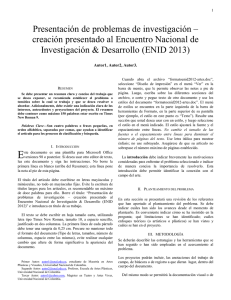
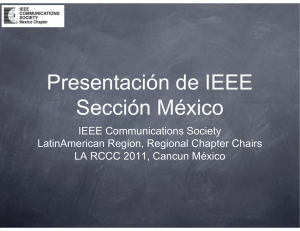
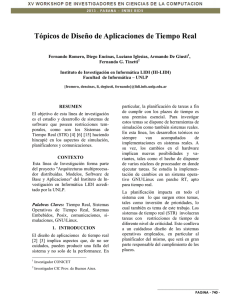
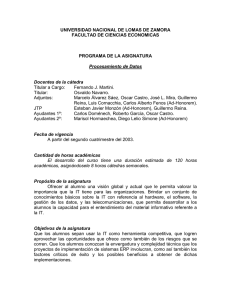
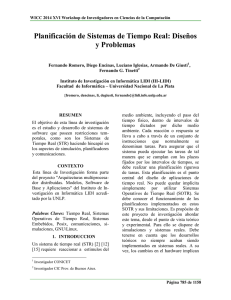
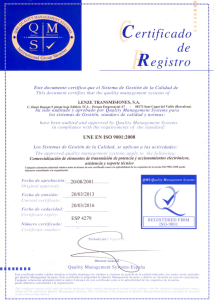
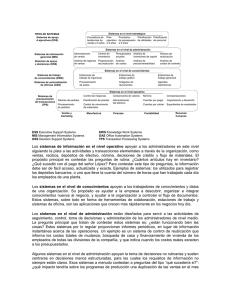
![[Presentación de la asignatura (curso 2006-2007)]](http://s2.studylib.es/store/data/003995270_1-0fccfb9d2fa5cee593ec960e12764c50-300x300.png)